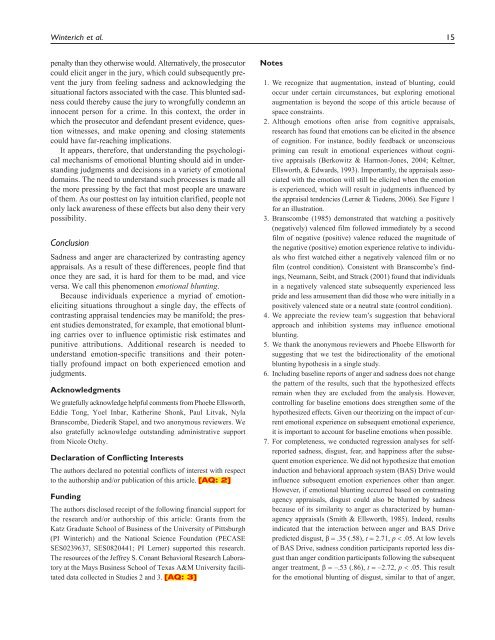The Role of Cognitive Appraisals in Emotional Blunting - Projects at ...
The Role of Cognitive Appraisals in Emotional Blunting - Projects at ...
The Role of Cognitive Appraisals in Emotional Blunting - Projects at ...
You also want an ePaper? Increase the reach of your titles
YUMPU automatically turns print PDFs into web optimized ePapers that Google loves.
W<strong>in</strong>terich et al. 15penalty than they otherwise would. Altern<strong>at</strong>ively, the prosecutorcould elicit anger <strong>in</strong> the jury, which could subsequently preventthe jury from feel<strong>in</strong>g sadness and acknowledg<strong>in</strong>g thesitu<strong>at</strong>ional factors associ<strong>at</strong>ed with the case. This blunted sadnesscould thereby cause the jury to wrongfully condemn an<strong>in</strong>nocent person for a crime. In this context, the order <strong>in</strong>which the prosecutor and defendant present evidence, questionwitnesses, and make open<strong>in</strong>g and clos<strong>in</strong>g st<strong>at</strong>ementscould have far-reach<strong>in</strong>g implic<strong>at</strong>ions.It appears, therefore, th<strong>at</strong> understand<strong>in</strong>g the psychologicalmechanisms <strong>of</strong> emotional blunt<strong>in</strong>g should aid <strong>in</strong> understand<strong>in</strong>gjudgments and decisions <strong>in</strong> a variety <strong>of</strong> emotionaldoma<strong>in</strong>s. <strong>The</strong> need to understand such processes is made allthe more press<strong>in</strong>g by the fact th<strong>at</strong> most people are unaware<strong>of</strong> them. As our posttest on lay <strong>in</strong>tuition clarified, people notonly lack awareness <strong>of</strong> these effects but also deny their verypossibility.ConclusionSadness and anger are characterized by contrast<strong>in</strong>g agencyappraisals. As a result <strong>of</strong> these differences, people f<strong>in</strong>d th<strong>at</strong>once they are sad, it is hard for them to be mad, and viceversa. We call this phenomenon emotional blunt<strong>in</strong>g.Because <strong>in</strong>dividuals experience a myriad <strong>of</strong> emotionelicit<strong>in</strong>gsitu<strong>at</strong>ions throughout a s<strong>in</strong>gle day, the effects <strong>of</strong>contrast<strong>in</strong>g appraisal tendencies may be manifold; the presentstudies demonstr<strong>at</strong>ed, for example, th<strong>at</strong> emotional blunt<strong>in</strong>gcarries over to <strong>in</strong>fluence optimistic risk estim<strong>at</strong>es andpunitive <strong>at</strong>tributions. Additional research is needed tounderstand emotion-specific transitions and their potentiallypr<strong>of</strong>ound impact on both experienced emotion andjudgments.AcknowledgmentsWe gr<strong>at</strong>efully acknowledge helpful comments from Phoebe Ellsworth,Eddie Tong, Yoel Inbar, K<strong>at</strong>her<strong>in</strong>e Shonk, Paul Litvak, NylaBranscombe, Diederik Stapel, and two anonymous reviewers. Wealso gr<strong>at</strong>efully acknowledge outstand<strong>in</strong>g adm<strong>in</strong>istr<strong>at</strong>ive supportfrom Nicole Otchy.Declar<strong>at</strong>ion <strong>of</strong> Conflict<strong>in</strong>g Interests<strong>The</strong> authors declared no potential conflicts <strong>of</strong> <strong>in</strong>terest with respectto the authorship and/or public<strong>at</strong>ion <strong>of</strong> this article. [AQ: 2]Fund<strong>in</strong>g<strong>The</strong> authors disclosed receipt <strong>of</strong> the follow<strong>in</strong>g f<strong>in</strong>ancial support forthe research and/or authorship <strong>of</strong> this article: Grants from theK<strong>at</strong>z Gradu<strong>at</strong>e School <strong>of</strong> Bus<strong>in</strong>ess <strong>of</strong> the University <strong>of</strong> Pittsburgh(PI W<strong>in</strong>terich) and the N<strong>at</strong>ional Science Found<strong>at</strong>ion (PECASESES0239637, SES0820441; PI Lerner) supported this research.<strong>The</strong> resources <strong>of</strong> the Jeffrey S. Conant Behavioral Research Labor<strong>at</strong>ory<strong>at</strong> the Mays Bus<strong>in</strong>ess School <strong>of</strong> Texas A&M University facilit<strong>at</strong>edd<strong>at</strong>a collected <strong>in</strong> Studies 2 and 3. [AQ: 3]Notes1. We recognize th<strong>at</strong> augment<strong>at</strong>ion, <strong>in</strong>stead <strong>of</strong> blunt<strong>in</strong>g, couldoccur under certa<strong>in</strong> circumstances, but explor<strong>in</strong>g emotionalaugment<strong>at</strong>ion is beyond the scope <strong>of</strong> this article because <strong>of</strong>space constra<strong>in</strong>ts.2. Although emotions <strong>of</strong>ten arise from cognitive appraisals,research has found th<strong>at</strong> emotions can be elicited <strong>in</strong> the absence<strong>of</strong> cognition. For <strong>in</strong>stance, bodily feedback or unconsciousprim<strong>in</strong>g can result <strong>in</strong> emotional experiences without cognitiveappraisals (Berkowitz & Harmon-Jones, 2004; Keltner,Ellsworth, & Edwards, 1993). Importantly, the appraisals associ<strong>at</strong>edwith the emotion will still be elicited when the emotionis experienced, which will result <strong>in</strong> judgments <strong>in</strong>fluenced bythe appraisal tendencies (Lerner & Tiedens, 2006). See Figure 1for an illustr<strong>at</strong>ion.3. Branscombe (1985) demonstr<strong>at</strong>ed th<strong>at</strong> w<strong>at</strong>ch<strong>in</strong>g a positively(neg<strong>at</strong>ively) valenced film followed immedi<strong>at</strong>ely by a secondfilm <strong>of</strong> neg<strong>at</strong>ive (positive) valence reduced the magnitude <strong>of</strong>the neg<strong>at</strong>ive (positive) emotion experience rel<strong>at</strong>ive to <strong>in</strong>dividualswho first w<strong>at</strong>ched either a neg<strong>at</strong>ively valenced film or n<strong>of</strong>ilm (control condition). Consistent with Branscombe’s f<strong>in</strong>d<strong>in</strong>gs,Neumann, Seibt, and Strack (2001) found th<strong>at</strong> <strong>in</strong>dividuals<strong>in</strong> a neg<strong>at</strong>ively valenced st<strong>at</strong>e subsequently experienced lesspride and less amusement than did those who were <strong>in</strong>itially <strong>in</strong> apositively valenced st<strong>at</strong>e or a neutral st<strong>at</strong>e (control condition).4. We appreci<strong>at</strong>e the review team’s suggestion th<strong>at</strong> behavioralapproach and <strong>in</strong>hibition systems may <strong>in</strong>fluence emotionalblunt<strong>in</strong>g.5. We thank the anonymous reviewers and Phoebe Ellsworth forsuggest<strong>in</strong>g th<strong>at</strong> we test the bidirectionality <strong>of</strong> the emotionalblunt<strong>in</strong>g hypothesis <strong>in</strong> a s<strong>in</strong>gle study.6. Includ<strong>in</strong>g basel<strong>in</strong>e reports <strong>of</strong> anger and sadness does not changethe p<strong>at</strong>tern <strong>of</strong> the results, such th<strong>at</strong> the hypothesized effectsrema<strong>in</strong> when they are excluded from the analysis. However,controll<strong>in</strong>g for basel<strong>in</strong>e emotions does strengthen some <strong>of</strong> thehypothesized effects. Given our theoriz<strong>in</strong>g on the impact <strong>of</strong> currentemotional experience on subsequent emotional experience,it is important to account for basel<strong>in</strong>e emotions when possible.7. For completeness, we conducted regression analyses for selfreportedsadness, disgust, fear, and happ<strong>in</strong>ess after the subsequentemotion experience. We did not hypothesize th<strong>at</strong> emotion<strong>in</strong>duction and behavioral approach system (BAS) Drive would<strong>in</strong>fluence subsequent emotion experiences other than anger.However, if emotional blunt<strong>in</strong>g occurred based on contrast<strong>in</strong>gagency appraisals, disgust could also be blunted by sadnessbecause <strong>of</strong> its similarity to anger as characterized by humanagencyappraisals (Smith & Ellsworth, 1985). Indeed, results<strong>in</strong>dic<strong>at</strong>ed th<strong>at</strong> the <strong>in</strong>teraction between anger and BAS Drivepredicted disgust, β .35 (.58), t 2.71, p .05. At low levels<strong>of</strong> BAS Drive, sadness condition participants reported less disgustthan anger condition participants follow<strong>in</strong>g the subsequentanger tre<strong>at</strong>ment, β –.53 (.86), t –2.72, p .05. This resultfor the emotional blunt<strong>in</strong>g <strong>of</strong> disgust, similar to th<strong>at</strong> <strong>of</strong> anger,
















